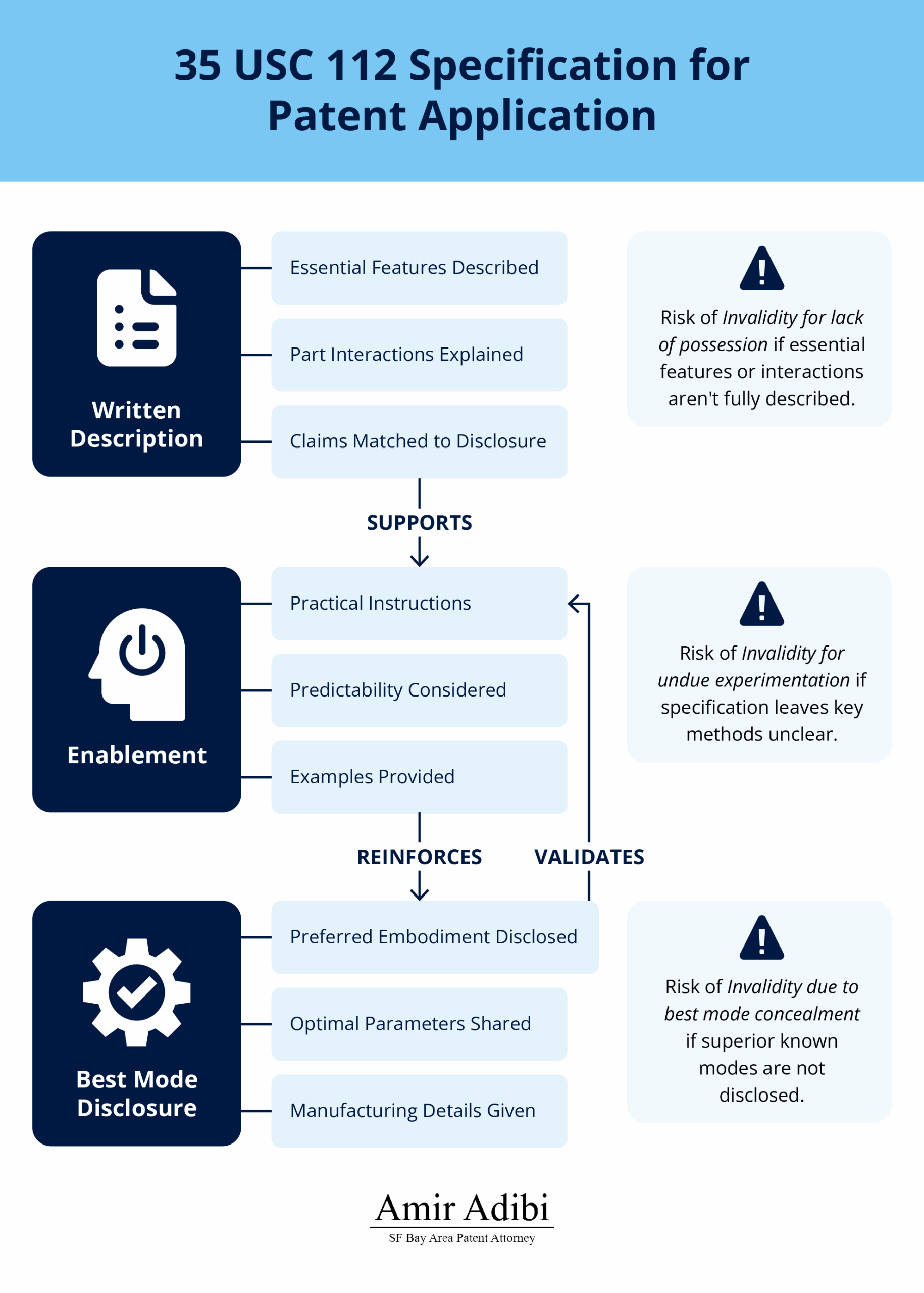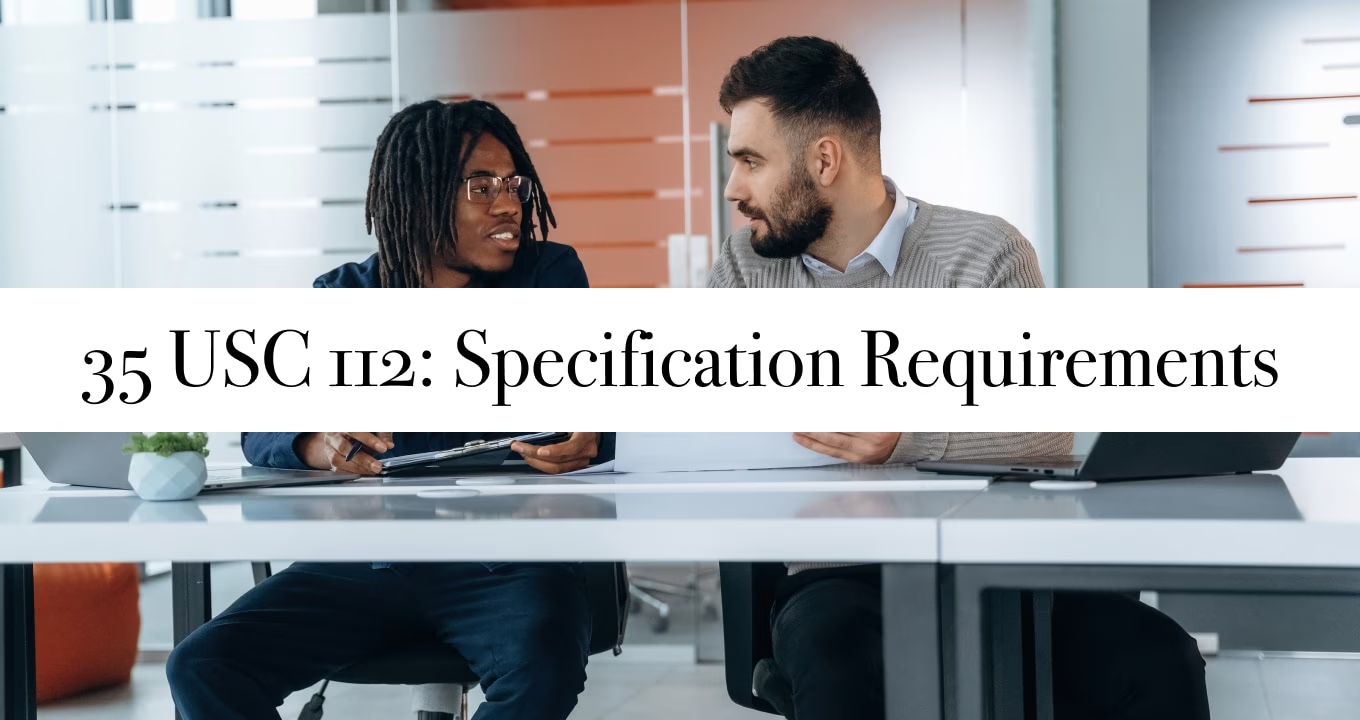Patent specifications are the bedrock of every strong patent application. They define both the boundaries of your invention and the strength of the protection you’ll receive. Section 35 USC 112 outlines three essential pillars that each patent specification must address: written description, enablement, and best mode disclosure. These components ensure that your patent communicates clearly to the public and secures the most robust protection possible.
Key Takeaways
- A proper specification must deliver a clear written description, explain how to make and use the invention, and share the best version known to the inventor.
- Technical depth is essential—someone skilled in the field should be able to reproduce the invention.
- The way you draft your specification can directly shape your patent’s strength and reach under 35 USC 112.

The Importance Of Specification In Patent Applications
You must teach the art precisely, because vague prose is like skyscrapers without beams—aesthetic but doomed under scrutiny. The specification anchors your claims, setting the legal boundary of what you can protect. If you skimp on component details, process steps, or alternative embodiments, examiners will narrow or reject your claims, and competitors will use your ambiguity against you. These pitfalls often result in patent rejections, and among the most common legal bases for them is 35 USC 112.
A robust specification covers:
- Parts and features with exact dimensions or materials.
- Procedural steps detailed enough to replicate without undue experimentation.
- Concrete examples spanning the full claim breadth.
- Preferred embodiments revealing the best mode you know.
In some patent applications however, meeting the enablement requirement under 35 USC 112 often requires more than just a detailed written disclosure. This is particularly true for inventions involving biological materials, such as those in biotechnology, where microorganisms, cell lines, or plasmids can be difficult or impossible to fully describe in words alone.
In these cases, inventors must deposit samples of the biological material at an approved depositary, like the ATCC, in accordance with 37 CFR 1.801–1.809. Others can then access the material necessary to practice the invention, fulfilling the enablement requirement by making the invention reproducible without undue experimentation.
By combining a thorough specification with timely biological deposits, you strengthen your patent’s foundation and better protect your invention from future disputes.
Core Components Of 35 USC 112(a)
Section 35 USC 112(a) outlines the key elements that must be met in the specification: written description, enablement, and best mode disclosure. These requirements work together to ensure that patent applications aren’t just ideas but complete technical contributions that the public can understand and build upon.
Written Description: Demonstrating Possession
Your spec must prove you actually invented what you claim. Think of it as your invention’s birth certificate. It’s a check against filing broad claims without figuring out the full invention.
To meet the written description requirement, your specification must:
- Clearly describe essential features
- Explain how different parts interact
- Match the breadth of the claims
- Offer enough examples or details to show complete understanding
Avoid “claim creep” by matching every claim element to specific passages or figures in your specification. If you claim “nanoparticle formulations,” describe at least one working example or the genus falls.
Case Example: In Hybritech, Inc. v. Monoclonal Antibodies, Inc. the Federal Circuit held that a specification disclosing only a general method for making hybridomas and the functional use of resultant antibodies in a “sandwich” immunoassay did not satisfy the written description requirement under 35 USC 112 for a broad genus claim; without any examples of representative monoclonal isolates or structural features delineating the full scope of the claimed antibody genus, the inventors had not demonstrated possession of the entire genus as of the filing date.
Enablement: Ensuring Practical Application
You owe the public a how-to manual, not an abstract theory. Under MPEP 2164, your disclosure must enable a person of ordinary skill to make and use the full scope of your claims without undue trial and error. If you claim a range of lab temperatures but omit your optimal protocol, examiners will cite you for undue experimentation, and judges will too. Without this, patent rejections are almost certain.
We evaluate enablement based on:
- How predictable the field of technology is
- How much instruction is included
- Whether practical examples are provided
- The complexity of the invention
- The state of existing knowledge
Case Example: In Atlas Powder Co. v. E.I. du Pont de Nemours Co. the court concluded that, although the specification described a prilling process for making granular ammonium nitrate by spraying and cooling, it provided only narrow operating parameters (e.g., specific temperatures and nozzle settings) and omitted critical process variables—such as spray‐droplet size and cooling‐rate control—so that a person of ordinary skill could not practice the full breadth of the claimed method without undue experimentation, thus failing the enablement requirement.
Best Mode: Disclosing The Preferred Embodiment
You can’t hide your secret sauce. Best mode bars you from claiming broad coverage while concealing your optimal conditions. Disclosure is key to obtaining a patent that will stand up in court and avoid invalidation under 35 USC 112.
This includes:
- Specific components or materials that work better
- Optimal operating parameters
- Key decisions and trade-offs
- Details relevant to manufacturing
Courts check both your statement and what you knew at the time of filing. If you discovered a superior catalyst before filing, you must include it or risk invalidation.
Case Example: In Chemcast Corp. v. ARCO Industries Corp. the Federal Circuit found that although the specification generically listed various free‐radical catalysts for methyl methacrylate polymerization, the inventor’s preferred and most effective catalysts—tertiary amines—were knowingly withheld; this concealment of the inventor’s best mode for carrying out the claimed process violated 35 U.S.C. 112(a)’s best‐mode requirement, even though the claim language itself was broader.
Legal Thresholds And Patent Examination
Patent examination is not just a check-the-box process. Examiners evaluate how well your application meets strict legal standards, particularly those under 35 U.S.C. 112. This is a common cause of patent rejections, especially for those unfamiliar with how to meet 35 USC 112 requirements during drafting. If your application lacks technical clarity or sufficient disclosure, it won’t pass.
Patent Examination And Compliance
Examiners follow MPEP guidelines to verify that your specification isn’t just prose but a technical manual. Their job is to confirm that your application teaches the invention clearly and thoroughly.
They test:
- Reproducibility: Can the art make it without undue guesswork?
- Possession: Does your disclosure show you had the full invention?
- Definiteness: Are claim terms clear and supported?
You need to be precise. Vague or overly general language can result in patent rejections and limit your ability to secure protection. Examiners look for clear explanations and consistent terminology.
Case Law And Judicial Interpretations
The courts, especially the Federal Circuit, have significantly influenced how Section 112 is interpreted. Their decisions clarify how thoroughly you must describe and enable your invention for the claims to hold.
Judges often zero in on whether the specification matches the full claim scope. The patent may be rejected or invalidated if the disclosure is narrower than the claims. This helps prevent applicants from claiming beyond what they’ve truly invented.
Enablement problems arise when the specification lacks detail or forces readers to guess. Courts have consistently said that presenting an idea is insufficient—you need to give practical, usable information.
Judicial decisions also make clear that high-level concepts won’t cut it. You need to go from concept to execution. That means details, not just theory.
Practical Strategies For Patent Drafting
A well-written patent doesn’t just check boxes—it anticipates challenges and answers them head-on. Drafting with care gives your patent the best chance of standing up in both examination and litigation under 35 USC 112.
Drafting Specifications To Avoid Rejections
Frame your spec like a blueprint: every beam, bolt, and weld called out. Use consistent terminology to prevent indefiniteness under § 112(b). Anchor abstract concepts with metaphors—“think of the disclosure bar like a dam: without proper gates, water (claims) overflows.”
Introduce “enablement burden” to remind inventors: broader claims raise a higher bar for detail. Label it in your draft as a checklist:
- Claim breadth ↔ working examples
- Technical scaffolding ↔ dependent claims
- Fallback scenarios ↔ strategic traps
Meeting these benchmarks improves your odds of obtaining a patent and defending it later.
Addressing Common Rejections
Rejections often happen when claim amendments exceed the original specification’s description. That’s why you must ensure every claimed feature is clearly supported from the start.
To avoid trouble later:
- Tie each claim to exact spots in the specification
- Keep records of changes and what supports them
- Respond to enablement concerns with added technical detail
- Include fallback positions in your original claim set
Understanding 35 USC 112 gives you the legal framing to respond to these issues confidently. When responding to rejections, be ready to show where the support lives in your original filing. The faster you can point to it, the faster the examiner can get back on board.
Maximizing Patent Scope And Validity
Balance is your strongest ally. Layer broad independent claims with narrow dependents to capture the market and survive invalidation. Use different claim formats—method, apparatus, system—to expand reach without overstepping your disclosure. Your drawings and enablement examples serve as proof that you not only sketched it—you built it. Avoid “claim creep” by aligning each term with text or figures.
Think of dependent claims as safety nets: if a broad skyscraper claim collapses, the narrower floors below remain intact. That’s how you maximize value when obtaining a patent while staying compliant with 35 USC 112.
Ready To Fortify Your Patent?
Strategic consulting can illuminate pitfalls you haven’t seen. A patent lawyer can guide you through these layers, ensuring you draft a specification that stands up to examiners, courts, and competitors alike.
Contact us to transform your specification into an unassailable fortress—because every word you file today defines the protection you’ll wield tomorrow.

